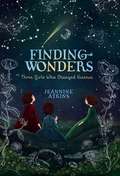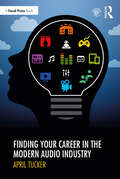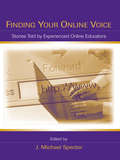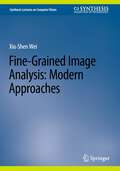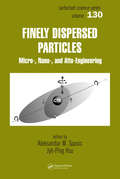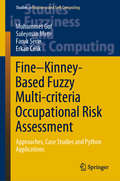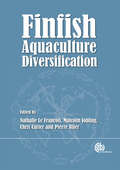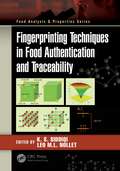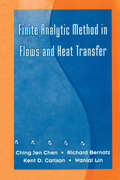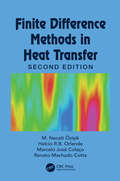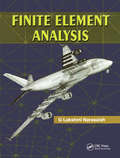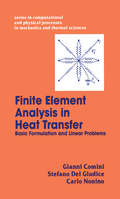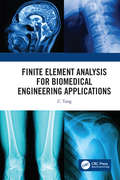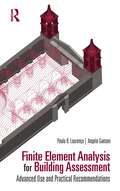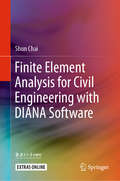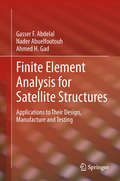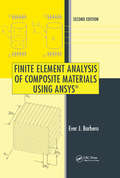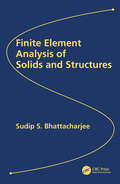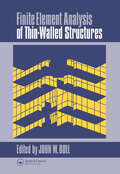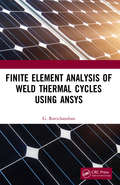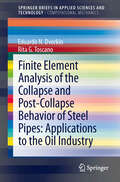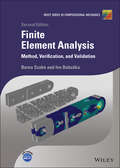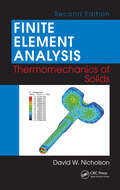- Table View
- List View
Finding Wonders: Three Girls Who Changed Science (Girls Who Love Science)
by Jeannine AtkinsThis &“evocative and beautiful&” (School Library Journal) novel &“vividly imagines the lives of three girls&” (Booklist, starred review) in three different time periods as they grow up to become groundbreaking scientists.Maria Merian was sure that caterpillars were not wicked things born from mud, as most people of her time believed. Through careful observation she discovered the truth about metamorphosis and documented her findings in gorgeous paintings of the life cycles of insects. More than a century later, Mary Anning helped her father collect stone sea creatures from the cliffs in southwest England. To him they were merely a source of income, but to Mary they held a stronger fascination. Intrepid and patient, she eventually discovered fossils that would change people&’s vision of the past. Across the ocean, Maria Mitchell helped her mapmaker father in the whaling village of Nantucket. At night they explored the starry sky through his telescope. Maria longed to discover a new comet—and after years of studying the night sky, she finally did. Told in vibrant, evocative poems, this stunning novel celebrates the joy of discovery and finding wonder in the world around us.
Finding Your Career in the Modern Audio Industry
by April TuckerFinding Your Career in the Modern Audio Industry equips the reader with the skills they need to turn an interest in audio, sound, or music technology into a career. This book provides insight for aspiring professionals seeking audio-related opportunities in entertainment, technology, education, and more. In the audio industry, there is typically a gap between those in-training and those with professional (and financially sustainable) careers. This book bridges the information gap, offering practical and real-world advice to those in this volatile stage of their career. Including 70+ interviews with professionals from over 20 countries, Finding Your Career in the Modern Audio Industry offers insight into how others (across the industry and the world) have applied entrepreneurial thinking, problem-solving, and creative solutions to build their careers. Including international case studies and interviews with diverse professionals, Finding Your Career in the Modern Audio Industry is essential reading for anyone taking their first steps into an audio-related field.
Finding Your Online Voice: Stories Told by Experienced Online Educators
by J. Michael SpectorFinding Your Online Voice offers a thought-provoking discussion of innovative approaches to technology-based distance education. Editor J. Michael Spector focuses on how highly experienced teachers conceptualize and organize online classes. Best practices and guidelines for effective online teaching as well as a set of instructor skills speci
Finding the Flavors We Lost: From Bread to Bourbon, How Artisans Reclaimed American Food
by Patric KuhThe multiple-James Beard Award–winning restaurant critic for Los Angeles Magazine delivers an arresting exploration of our cultural demand for “artisanal” foods in a world dominated by corporate agribusiness.We hear the word “artisanal” all the time—attached to cheese, chocolate, coffee, even fast-food chain sandwiches—but what does it actually mean? We take “farm to table” and “handcrafted food” for granted now but how did we get here? In Finding the Flavors We Lost, acclaimed food writer Patric Kuh profiles major figures in the so-called “artisanal” food movement who brought exceptional taste back to food and inspired chefs and restaurateurs to redefine and rethink the way we eat.Kuh begins by narrating the entertaining stories of countercultural “radicals” who taught themselves the forgotten crafts of bread, cheese, and beer-making in reaction to the ever-present marketing of bland, mass-produced food, and how these people became the inspiration for today’s crop of young chefs and artisans. Finding the Flavors We Lost also analyzes how population growth, speedier transportation, and the societal shifts and economic progress of the twentieth century led to the rise of supermarkets and giant food corporations, which encouraged the general desire to swap effort and quality for convenience and quantity.Kuh examines how a rediscovery of the value of craft and individual effort has fueled today’s popularity and appreciation for artisanal food and the transformations this has effected on both the restaurant menu and the dinner table. Throughout the book, he raises a host of critical questions. How big of an operation is too big for a food company to still call themselves “artisanal”? Does the high cost of handcrafted goods unintentionally make them unaffordable for many Americans? Does technological progress have to quash flavor? Eye-opening, informative, and entertaining, Finding the Flavors We Lost is a fresh look into the culture of artisan food as we know it today—and what its future may be.
Fine-Grained Image Analysis: Modern Approaches (Synthesis Lectures on Computer Vision)
by Xiu-Shen WeiThis book provides a comprehensive overview of the fine-grained image analysis research and modern approaches based on deep learning, spanning the full range of topics needed for designing operational fine-grained image systems. The author begins by providing detailed background information on FGIA, focusing on recognition and retrieval. The author also provides the fundamentals of convolutional neural networks to further make it easier for readers to understand the technical content in the book. The book introduces the main technical paradigms, technological developments, and representative approaches of fine-grained image recognition and fine-grained image retrieval. The author covers multiple popular research topics and includes cross-domain knowledge. The book also highlights advanced applications and topics for future research.
Finely Dispersed Particles: Micro-, Nano-, and Atto-Engineering
by Aleksandar M. Spasic Jyh-Ping HsuOver the last decade, the biggest advances in physical chemistry have come from thinking smaller. The leading edge in research pushes closer to the atomic frontier with every passing year. Collecting the latest developments in the science and engineering of finely dispersed particles and related systems, Finely Dispersed Particles: Micro-, Nano-, a
Fine–Kinney-Based Fuzzy Multi-criteria Occupational Risk Assessment: Approaches, Case Studies and Python Applications (Studies in Fuzziness and Soft Computing #398)
by Muhammet Gul Suleyman Mete Faruk Serin Erkan CelikThis book presents a number of approaches to Fine–Kinney–based multi-criteria occupational risk-assessment. For each proposed approach, it provides case studies demonstrating their applicability, as well as Python coding, which will enable readers to implement them into their own risk assessment process. The book begins by giving a review of Fine–Kinney occupational risk-assessment methods and their extension by fuzzy sets. It then progresses in a logical fashion, dedicating a chapter to each approach, including the fuzzy best and worst method, interval-valued Pythagorean fuzzy VIKOR and interval type-2 fuzzy QUALIFLEX. This book will be of interest to professionals and researchers working in the field of occupational risk management, as well as postgraduate and undergraduate students studying applications of fuzzy systems.
Finfish Aquaculture: Species Selection for Diversification
by Malcolm Jobling Chris Carter Pierre U. Blier Natalie R. Le FrançoisThere is considerable global interest in the culture of finfish species both for cold and warm water aquaculture development and growth. Essential information on the biology, domestication and aquacultural characteristics of a wide selection of novel and established species is provided in the form of technical sheets, species descriptions and information on current rearing practices, making this a must-have reference in the field of aquacultural science. The book also offers a basic framework in order to support investment strategies for research and development efforts aimed at the emergence of a profitable finfish aquaculture industry and presents a rationale for species diversification, different approaches to species selection and basic economic and market considerations governing the launch of strategic development and commercialization efforts.
Fingerprinting Techniques in Food Authentication and Traceability (Food Analysis & Properties)
by Leo M.L. Nollet K. S. SiddiqiThere is an increasing interest by consumers for high-quality food products with a clear geographical origin. With these products in demand, suitable analytical techniques are needed for the quality control. Current analytical approaches are mass spectrometry techniques, spectroscopic techniques, separation techniques, and others. Fingerprinting Techniques in Food Authentication and Traceability discusses the principles of the techniques together with their advantages and drawbacks, and reported applications concerning geographical authenticity. A combination of methods analyzing different types of food compounds seems to be the most promising approach to establish the geographical origin. The abundant acquired data are analyzed by chemometrics. Producing safe and high-quality food is a prerequisite to ensure consumer health and successful domestic and international trade, and is critical to the sustainable development of national agricultural resources. Systems to trace food or feed products through specified stages of production, processing, and distribution play a key role in assuring food safety. Analytical techniques that enable the provenance of food to be determined provide an independent means of verifying traceability systems and also help to prove product authenticity, to combat fraudulent practices and to control adulteration, which are important issues for economic, religious, or cultural reasons. Proof of provenance has become an important topic in the context of food safety, food quality, and consumer protection in accordance with national legislation and international standards and guidelines.
Finite Analytic Method in Flows and Heat Transfer
by R. A. BernatzThis book contains the fundamental development of the finite analytic method and gives a systematic coverage of knowledge needed for numerical computation of fluid flows and heat transfer. It will be helpful to many including graduate students studying computational fluid dynamics and heat transfer.
Finite Approximations in Discrete-Time Stochastic Control: Quantized Models And Asymptotic Optimality (Systems And Control: Foundations And Applications Ser.)
by Serdar Yüksel Naci Saldi Tamás LinderIn a unified form, this monograph presents fundamental results on the approximation of centralized and decentralized stochastic control problems, with uncountable state, measurement, and action spaces. It demonstrates how quantization provides a system-independent and constructive method for the reduction of a system with Borel spaces to one with finite state, measurement, and action spaces. In addition to this constructive view, the book considers both the information transmission approach for discretization of actions, and the computational approach for discretization of states and actions. Part I of the text discusses Markov decision processes and their finite-state or finite-action approximations, while Part II builds from there to finite approximations in decentralized stochastic control problems. This volume is perfect for researchers and graduate students interested in stochastic controls. With the tools presented, readers will be able to establish the convergence of approximation models to original models and the methods are general enough that researchers can build corresponding approximation results, typically with no additional assumptions.
Finite Difference Methods in Heat Transfer (Heat Transfer)
by Renato M. Cotta M. Necati Özişik Helcio R. Orlande Marcelo J. ColaçoFinite Difference Methods in Heat Transfer, Second Edition focuses on finite difference methods and their application to the solution of heat transfer problems. Such methods are based on the discretization of governing equations, initial and boundary conditions, which then replace a continuous partial differential problem by a system of algebraic equations. Finite difference methods are a versatile tool for scientists and for engineers. This updated book serves university students taking graduate-level coursework in heat transfer, as well as being an important reference for researchers and engineering. Features Provides a self-contained approach in finite difference methods for students and professionals Covers the use of finite difference methods in convective, conductive, and radiative heat transfer Presents numerical solution techniques to elliptic, parabolic, and hyperbolic problems Includes hybrid analytical–numerical approaches
Finite Element Analysis
by Lakshmi NarasaihaThe finite element method has undergone a major paradigm shift from a detailed mathematical background for writing tailor-made computer programs to a user-based approach for applying available software to engineering analysis and design scenarios. This textbook begins with a concise overview of fluid mechanics, motivated by numerous engineering app
Finite Element Analysis In Heat Transfer: Basic Formulation & Linear Problems (Computational and Physical Processes in Mechanics and Thermal Sciences)
by Gianni CominiThis introductory text presents the applications of the finite element method to the analysis of conduction and convection problems. The book is divided into seven chapters which include basic ideas, application of these ideas to relevant problems, and development of solutions. Important concepts are illustrated with examples. Computer problems are also included to facilitate the types of solutions discussed.
Finite Element Analysis for Biomedical Engineering Applications
by Z. C. YangFinite element analysis has been widely applied to study biomedical problems. This book aims to simulate some common medical problems using finite element advanced technologies, which establish a base for medical researchers to conduct further investigations. This book consists of four main parts: (1) bone, (2) soft tissues, (3) joints, and (4) implants. Each part starts with the structure and function of the biology and then follows the corresponding finite element advanced features, such as anisotropic nonlinear material, multidimensional interpolation, XFEM, fiber enhancement, UserHyper, porous media, wear, and crack growth fatigue analysis. The final section presents some specific biomedical problems, such as abdominal aortic aneurysm, intervertebral disc, head impact, knee contact, and SMA cardiovascular stent. All modeling files are attached in the appendixes of the book. This book will be helpful to graduate students and researchers in the biomedical field who engage in simulations of biomedical problems. The book also provides all readers with a better understanding of current advanced finite element technologies. Details finite element modeling of bone, soft tissues, joints, and implants Presents advanced finite element technologies, such as fiber enhancement, porous media, wear, and crack growth fatigue analysis Discusses specific biomedical problems, such as abdominal aortic aneurysm, intervertebral disc, head impact, knee contact, and SMA cardiovascular stent Explains principles for modeling biology Provides various descriptive modeling files
Finite Element Analysis for Building Assessment: Advanced Use and Practical Recommendations (Assessment, Repair and Strengthening for the Conservation of Structures)
by Paulo B. Lourenço Angelo GaetaniExisting structures represent a heterogeneous category in the global built environment as often characterized by the presence of archaic materials, damage and disconnections, uncommon construction techniques and subsequent interventions throughout the building history. In this scenario, the common linear elastic analysis approach adopted for new buildings is incapable of an accurate estimation of structural capacity, leading to overconservative results, invasive structural strengthening, added intervention costs, excessive interference to building users and possible losses in terms of aesthetics or heritage values. For a rational and sustainable use of the resources, this book deals with advanced numerical simulations, adopting a practical approach to introduce the fundamentals of Finite Element Method, nonlinear solution procedures and constitutive material models. Recommended material properties for masonry, timber, reinforced concrete, iron and steel are discussed according to experimental evidence, building standards and codes of practice. The examples examined throughout the book and in the conclusive chapter support the analyst’s decision-making process toward a safe and efficient use of finite element analysis. Written primarily for practicing engineers, the book is of value to students in engineering and technical architecture with solid knowledge in the field of continuum mechanics and structural design.
Finite Element Analysis for Civil Engineering with DIANA Software
by Shun ChaiThis book systematically introduces readers to the finite element analysis software DIANA (DIsplacement ANAlyzer) and its applications in civil engineering. Developed by TNO Corporation in the 1970s, DIANA is frequently used in civil engineering and engineering mechanics. Unlike the software user’s manual, which provides a comprehensive introduction and theoretical analysis, this book presents a simplified overview of the basic background theory to help beginners master the software quickly. It also discusses GUI operation and the command console in Python language, and includes examples involving classical modeling operations to help readers review each section. Both the book and DIANA itself are valuable resources for students and researchers in all the structural engineering fields, such as civil engineering, bridge engineering, geotechnical engineering, tunnel engineering, underground structural engineering, irrigation, municipal engineering and fire engineering.
Finite Element Analysis for Satellite Structures
by Nader Abuelfoutouh Gasser F. Abdelal Ahmed H. GadDesigning satellite structures poses an ongoing challenge as the interaction between analysis, experimental testing, and manufacturing phases is underdeveloped. Finite Element Analysis for Satellite Structures: Applications to Their Design, Manufacture and Testing explains the theoretical and practical knowledge needed to perform design of satellite structures. By layering detailed practical discussions with fully developed examples, Finite Element Analysis for Satellite Structures: Applications to Their Design, Manufacture and Testing provides the missing link between theory and implementation. Computational examples cover all the major aspects of advanced analysis; including modal analysis, harmonic analysis, mechanical and thermal fatigue analysis using finite element method. Test cases are included to support explanations an a range of different manufacturing simulation techniques are described from riveting to shot peening to material cutting. Mechanical design of a satellites structures are covered in three steps: analysis step under design loads, experimental testing to verify design, and manufacturing. Stress engineers, lecturers, researchers and students will find Finite Element Analysis for Satellite Structures: Applications to Their Design, Manufacture and Testing a key guide on with practical instruction on applying manufacturing simulations to improve their design and reduce project cost, how to prepare static and dynamic test specifications, and how to use finite element method to investigate in more details any component that may fail during testing.
Finite Element Analysis of Composite Materials Using ANSYS
by Ever J. BarberoDesigning structures using composite materials poses unique challenges, especially due to the need for concurrent design of both material and structure. Students are faced with two options: textbooks that teach the theory of advanced mechanics of composites, but lack computational examples of advanced analysis, and books on finite element analysis
Finite Element Analysis of Solids and Structures
by Sudip S. BhattacharjeeFinite Element Analysis of Solids and Structures combines the theory of elasticity (advanced analytical treatment of stress analysis problems) and finite element methods (numerical details of finite element formulations) into one academic course derived from the author’s teaching, research, and applied work in automotive product development as well as in civil structural analysis. Features Gives equal weight to the theoretical details and FEA software use for problem solution by using finite element software packages Emphasizes understanding the deformation behavior of finite elements that directly affect the quality of actual analysis results Reduces the focus on hand calculation of property matrices, thus freeing up time to do more software experimentation with different FEA formulations Includes chapters dedicated to showing the use of FEA models in engineering assessment for strength, fatigue, and structural vibration properties Features an easy to follow format for guided learning and practice problems to be solved by using FEA software package, and with hand calculations for model validation This textbook contains 12 discrete chapters that can be covered in a single semester university graduate course on finite element analysis methods. It also serves as a reference for practicing engineers working on design assessment and analysis of solids and structures. Teaching ancillaries include a solutions manual (with data files) and lecture slides for adopting professors.
Finite Element Analysis of Thin-Walled Structures
by John W. BullThis book describes current developments in finite element analysis and the design of certain types of thin-walled structures. The first three chapters lay the foundations for the development and use of finite elements for thin-walled structures, look at finite elements packages and discuss data input and mesh arrangements. The final four chapters use the finite element method to assist in the solution of thin-walled structure problems. Some of the problems solved include; water and air inflated structures; axisymmetric thin shells; ship structures and offshore structures. This book will be an interest to design engineers, researchers and postgraduates.
Finite Element Analysis of Weld Thermal Cycles Using ANSYS
by G. RavichandranFinite Element Analysis of Weld Thermal Cycles Using ANSYS aims at educating a young researcher on the transient analysis of welding thermal cycles using ANSYS. It essentially deals with the methods of calculation of the arc heat in a welded component when the analysis is simplified into either a cross sectional analysis or an in-plane analysis. The book covers five different cases involving different welding processes, component geometry, size of the element and dissimilar material properties. A detailed step by step calculation is presented followed by APDL program listing and output charts from ANSYS. Features: Provides useful background information on welding processes, thermal cycles and finite element method Presents calculation procedure for determining the arc heat input in a cross sectional analysis and an in-plane analysis Enables visualization of the arc heat in a FEM model for various positions of the arc Discusses analysis of advanced cases like dissimilar welding and circumferential welding Includes step by step procedure for running the analysis with typical input APDL program listing and output charts from ANSYS.
Finite Element Analysis of the Collapse and Post-Collapse Behavior of Steel Pipes: Applications to the Oil Industry
by Eduardo N Dvorkin Rita G. ToscanoThis book presents a detailed discussion of the models that were developed to simulate the collapse and post-collapse behavior of steel pipes. The finite element method offers to engineers the possibility of developing models to simulate the collapse behavior of casings inside oil wells and the collapse behavior of deepwater pipelines. However, if technological decisions are going to be reached from these model results, with implications for the economic success of industrial operations, for the occupational safety and health and for the environment, the engineering models need to be highly reliable. Using these models engineers can quantify the effect of manufacturing tolerances, wear, corrosion, etc. This book describes in great details the experimental programs that are developed to validate the numerical results.
Finite Element Analysis: Method, Verification and Validation (Wiley Series in Computational Mechanics)
by Barna Szabó Ivo BabuškaFinite Element Analysis An updated and comprehensive review of the theoretical foundation of the finite element method The revised and updated second edition of Finite Element Analysis: Method, Verification, and Validation offers a comprehensive review of the theoretical foundations of the finite element method and highlights the fundamentals of solution verification, validation, and uncertainty quantification. Written by noted experts on the topic, the book covers the theoretical fundamentals as well as the algorithmic structure of the finite element method. The text contains numerous examples and helpful exercises that clearly illustrate the techniques and procedures needed for accurate estimation of the quantities of interest. In addition, the authors describe the technical requirements for the formulation and application of design rules. Designed as an accessible resource, the book has a companion website that contains a solutions manual, PowerPoint slides for instructors, and a link to finite element software. This important text: Offers a comprehensive review of the theoretical foundations of the finite element method Puts the focus on the fundamentals of solution verification, validation, and uncertainty quantification Presents the techniques and procedures of quality assurance in numerical solutions of mathematical problems Contains numerous examples and exercises Written for students in mechanical and civil engineering, analysts seeking professional certification, and applied mathematicians, Finite Element Analysis: Method, Verification, and Validation, Second Edition includes the tools, concepts, techniques, and procedures that help with an understanding of finite element analysis.
Finite Element Analysis: Thermomechanics of Solids, Second Edition
by David W. NicholsonExplore a Unified Treatment of the Finite Element MethodThe finite element method has matured to the point that it can accurately and reliably be used, by a careful analyst, for an amazingly wide range of applications. With expanded coverage and an increase in fully solved examples, the second edition of Finite Element Analysis: Thermomechan
